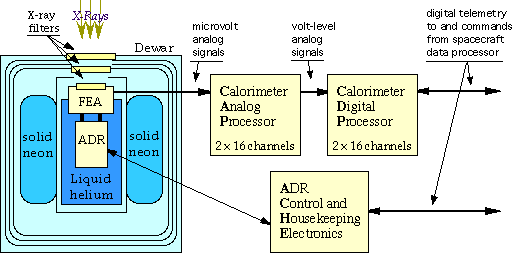The XRS Instrument
The detectors in XRS are X-ray
microcalorimeters.
They work by monitoring the temperature of a tiny
piece of silicon, and measuring the temperature rise that results
when it absorbs an X-ray photon.
You might imagine that measuring the temperature rise from a single photon is
fairly difficult, and you'd be right! Briefly, here is how we do it:
- First, the X-rays must be focused onto the detectors. This is done with a set
of conical mirrors made of hundreds of layers of very thin foil.
- The detectors need to be kept extremely cold (60 milliKelvin).
This requires a complex cryogenic
system, including liquid helium
and solid neon. It also requires the use of several filters to keep out stray
light, radio waves, and any other radiation other than X-rays.
- The signals from the detectors are amplified and shaped by a package of analog
electronics and then processed digitally to determine the energy of each photon.
Here is a block diagram of the instrument (minus the
mirrors), and a brief
description of each subsystem. You can click on the diagram, or follow the links
in the descriptions to learn more about the various subsystems.

- FEA
- The Front-End Assembly holds the array of 32 detectors at the focus of the X-ray
mirrors, keeping them at a temperature of 60
milliKelvin (mK).
The FEA also contains the first stage of signal amplification.
-
ADR
- The Adiabatic Demagnetization Refrigerator
controls the temperature of the FEA. This keeps the
detectors at 60 mK and is stable to about 10 microKelvin.
- Helium insert
- The cryogenic insert (or "helium insert") contains the FEA and ADR,
along with about 30 liters of liquid helium.
- dewar
- The dewar
is an insulated container to keep
everything cold. It consists of a
jacket of solid neon, which surrounds the liquid helium filled insert.
The heat from the detectors and amplifiers, plus the stray
heat that leaks in from the outside, ultimately goes into melting the solid neon. When
it is gone (after about 2 years in orbit), XRS will no longer function.
- filters
- These are a set of 5 extremely thin sheets of
metal (only 3 are shown above) which let the X-rays
through to the detectors, but keep out other radiation (such
as ultraviolet, visible, or infrared light).
-
CAP
- The Calorimeter Analog Processor powers the
detectors and amplifies their signals by a factor of 20000.
The amplified signals are sent to the CDP (see below).
-
CDP
- The Calorimeter Digital Processor analyzes the amplified signals
to determine the energy of each X-ray that hits a detector. The CDP digitizes the
data from the CAP and monitors the data stream. When it detects the pulse from an
X-ray, the signal is analyzed to determine the energy of the photon, and the resulting
data is sent to the spacecraft for later transmission to the ground.
-
ACHE
- The ADR Control and Housekeeping Electronics controls and cycles the
ADR. The ACHE contains all the electronics for controlling the temperature of the ADR.
- mirrors
- (not shown above) The conical foil mirrors focus the X-rays onto the detectors.
- spacecraft
- XRS is a part of the Japanese ASTRO-E spacecraft. The spacecraft
provides power and a stable thermal environment, as well as storing
commands from the ground and data to be transmitted.